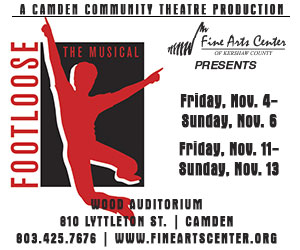Special: Artist Bruce Nellsmith Writes About Six Women Who Make a Difference in Columbia Arts
This article focuses on six women who have made significant contributions to the Greater Columbia Arts Community. I chose these women, from a long list of equally qualified candidates, because of their tireless commitment to the arts and their community. Next year, it will be another artist’s opportunity to select six accomplished and illustrious women. But for this year, it was my honor.
“While surrounded by America’s perfect storm of unaccountability and malfeasance in all disciplines and levels, all six persevere in their own way to bring some sense of the value of talent and vision.” – Stephen Chesley
Toni Elkins
As I am about to settle into the luxurious comfort of one of her couches, artist Toni Elkins returns from her kitchen with a glass of wine in her hand and plops down on the floor. She has a warm and inviting personality, is generous with her time, energy, and resources, and has a talent for making nearly anyone feel as though they are her best friend.
An internationally award-winning artist, a philanthropist, and options trader in the stock market, Elkins was a superintendent for the South Carolina State Fair Arts Department, organizing the annual exhibit, recruiting volunteers, and raising funds for awards when I first met her. She was the first artist from South Carolina to be elected into the Watercolor USA Honor Society and has received the Nautilus Fellowship from the International Society of Experimental Artists.
From modest efforts like supporting the Literature and Arts Festival of the Richland Two Education Foundation or the Columbia Jewish Day School to more visionary endeavors, such as creating Muses at Trustus Theater and helping to found Women in Philanthropy and the Palmetto Health Foundation’s Women’s Leadership Circle, Elkins often can be found at the heart of what matters. Coralee Harris, a fellow philanthropist who has served on several arts and humanities boards with Elkins, says: “She has a huge heart and is very sensitive to the people issues that oftentimes present themselves when a committee tries to resolve an issue. She is effective at separating the people from the task to reach resolution; she does so with creativity and purpose. Toni has served as President of the SC Watercolor Society and Fine Arts Consultant for the State Fair. This past year, she also served as Honorary Chair for Women in Philanthropy’s Power of the Purse Event. In addition, she has received the Elizabeth O’Neil Verner Award, given by the governor, for her contributions to the arts community in South Carolina.”
Elkins’ advice to other artists? “Be yourself, go your own direction; if you lose yourself you have lost what’s most valuable.”
Karen Brosius
Knowing that I had just interviewed Karen Brosius for this article, City Art Gallery Owner and Director Wendyth Wells asks me during a recent gallery visit what I thought of the Executive Director of the Columbia Museum of Art. “Didn’t you think she has a way of making everyone feel as though they are a friend?” Wells queries. Simply put: yes. One of the first topics of my conversation with Brosius was her mission to make the museum feel like “Columbia’s living room … a place for people to gather with friends, a place you want to be.”
Prior to taking her position at CMA, Brosius worked for 21 years with the Altria Group – the parent company of Kraft Foods and Phillip Morris – where she served as a senior philanthropic, arts, and communications executive, working on the exhibitions and major retrospectives of artists including Jasper Johns, Robert Rauschenberg, Jacob Lawrence, Louise Bourgeois, Frida Kahlo, and more. Already during her tenure at CMA, she arranged for the “Turner to Cezanne” exhibit, which included works never before shown in the United States, with CMA serving as the first stop on the exhibit’s national tour. Prior to that, Brosius borrowed two paintings by Pierre-Auguste Renoir from the Art Institute of Chicago for six months, which was the first time a Renoir had been on public view anywhere in South Carolina, she recalls. Crediting the contributions of dedicated donors and board members who help to sponsor such high-caliber exhibitions, Joe and Melissa Blanchard, and the Contemporaries who raise money to support purchases, Brosius proposes that the CMA is poised to be the State’s Museum.
Others in the know when it comes to Columbia arts agree. According to Stephen Nevitt, Professor of Art at Columbia College, “Karen’s contributions to the arts in the Midlands have been profound.” Jeffrey Day, former arts editor for The State newspaper, puts it most succinctly. “The museum has been transformed – in a good way – since Karen Brosius arrived,” he says. “She certainly hasn’t done it alone; the museum has an amazing, hard-working, and creative staff, but she’s the boss and hired many of them. The museum has finally become the museum we deserve under her leadership”.
Heidi Darr-Hope
Heidi Darr-Hope has invited a lot of people into her dreams over the past 12 years – people in need of finding something within themselves that can promote healing. The Columbia artist uses art to help cancer patients unleash creative ways of harnessing a deeper understanding of what they are going through and, more important, realize hope in a journey toward recovery and self-discovery.
Having taught in Palmetto Health’s Psychosocial Oncology Program until it was discontinued in 1990, Darr-Hope soon afterwards established a non-profit program called Healing Icons, which invites cancer patients to create works of art made from found objects, paint, and various collage elements to form an artwork that embodies and focuses the patient’s fears, hopes, dreams, and misgivings. This visual and personal icon can lead the patient not only to a deeper understanding of their feelings as they navigate the complexities of cancer treatment, but, Darr-Hope points out, “it can help the patient to better communicate with families and friends some of the feelings they incur that they may be less than able to articulate through words.”
Darr-Hope’s studio has the feel of a curiosity shop, with apothecary-like drawers filled with bone fragments, insects, small stones, seeds, hair, feathers, you name it – this is her palette. Darr-Hope is best described as a sculptor working in found object combinations. Her own work is iconic, and she often combines objects in a shadow-box form in ways that, once their meanings are deciphered, form a kind of narrative that Darr-Hope says is often “pulled directly out of a dream.”
While Darr-Hope says that her artwork stems from a trust in the “subconscious or un-conscious,” there is a formal side to her work, as well, stemming from her education. She holds a Master of Fine Arts degree as well as certification in Jungian dream analysis.
While trying to establish Healing Icons, Darr-Hope’s says her biggest challenge was “to convince the right-brained, medical establishment that there was more to healing than medicine,” she says, adding: “Trust me, I’m an artist.”
Harriett Green
There’s a rhythm to conversation with Harriet Green. It starts casual, then turns to the serious and sharply focused, and then to entertaining. The Visual Arts Director of the South Carolina Arts Commission (SCAC) for 24 years, Green hints at retirement, but it’s hard to put the brakes on a bullet. From 1980-1988, Green was Registrar and Assistant Curator at the Columbia Museum of Art. Now she is the Curator of the SCAC State Art Collection. With an academic background in art history, she has written numerous exhibition catalogue essays and was a board member of the Alternative Museum in New York City.
Although she has spent much of her time at the SCAC raising funds to benefit artists, she says, “I don’t think I would have the stomach for being an artist. … There is the rejection. … Honestly, I knew early on that I had no real talent, and I didn’t have the temperament for it either.” Nonetheless, Green takes a creative and innovative approach to her work as an arts administrator. As she presented me with various catalogues representing some of the exhibitions she has curated over the years, her pride in those accomplishments became evident, as so it should be.
Wendyth Wells
The best art may not always float to the top, but, regionally, it often does come to the attention of Wendyth Wells, owner and director of City Art Gallery. It is her business to gather what she deems to be some of the best professional and highest-quality original artwork into one place – her place. You will not find posters or giclees in her gallery, located in Columbia’s Vista. Here, you will find only the paintings, artist’s prints, drawings, and sculpture that came directly from the hand of the artist that produced them.
The roots of the City Art Gallery go back to 1977, when Wendyth Wells, having completed degrees in political science and art, moved to South Carolina to help her mother operate her crafts supply business, The Dutch Door, in the Boozer Shopping Center. Wells’ contribution to the business was to offer a selection of fine art supplies. She soon began to sell work by local artists, making use of the storefront windows to display their work. “When we finally moved to the Vista,” she says, “we kept our corporate name – Dutch Door, but changed the name of the gallery.”
An artist with many awards and exhibitions under her belt, Wells is also an advocate for art ownership. “People who buy that first piece of real art continue to buy it, but you have to experience what it’s like to own and live with that first piece,” she says. “I mean, don’t you think it’s amazing that you can own something someone has put onto a canvas?” There is a reverence in Wells’ statement that speaks to the respect and admiration she has for this community of artists and their struggle to accomplish and share with others.
Kristin Cobb
More often it is the art historian or arts educator that eventually finds herself in the position of arts administrator, not an actor. But when I asked Kristin Cobb, Executive Director of the Kershaw County Fine Arts Center in Camden, how she found herself in this role of an arts administrator, she had a simple answer: “Well, I was really supposed to be famous.” Cobb’s involvement in acting began when, as an eighth grader, she appeared on stage for the first time in one of Larry Hembree’s productions in the Bassett Theater on the campus of the Kershaw County Fine Arts Center.
“Larry says that I probably hold the record for the number of appearances in his plays here at the Center,” Cobb says. Who better to take the helm than someone who artistically grew up in the theater?
Coming full circle, Cobb was shaped by the many outreach programs of the Kershaw County Fine Arts Center; now she is responsible for shaping the present and future of that same Center. Full of energy as we climb the steps to the 284-seat Bassett Theater, where a production of the musical “Chicago” is being readied, Cobb sings out, “Give ’em the ol’ razzle-dazzle!”
Under Cobb’s direction, the Center does just that for the residents of Camden, with a burgeoning schedule of events featuring nationally and regionally known artists and performers. But there is a lot more to the Center than a box office, theater, and gallery. It has an extensive outreach program into the area’s public schools. Through the Center’s Daniels Foundation, an artist-in-residence has been placed in every school in the district. In addition to the Bassett Theater and Gallery, the Center boasts numerous well-equipped classrooms and studios for dance, painting, drawing, clay arts, and music. During the summer months, as many as 120 children can be found on the campus.
“We have really seen the classes grow, and when I became the director, I thought that the diversity of what we have to offer would be key to our survival,” she says. “I saw diverse programming as the way we would take things to the next level. You may not like chamber music, but you may attend a blues concert. You may not take a music class, but you may take a clay class.” Cobb adds that she feels “fortunate to have a place to work like this.”






.jpg)
